2015 NISSAN GT-R radiator
[x] Cancel search: radiatorPage 30 of 358
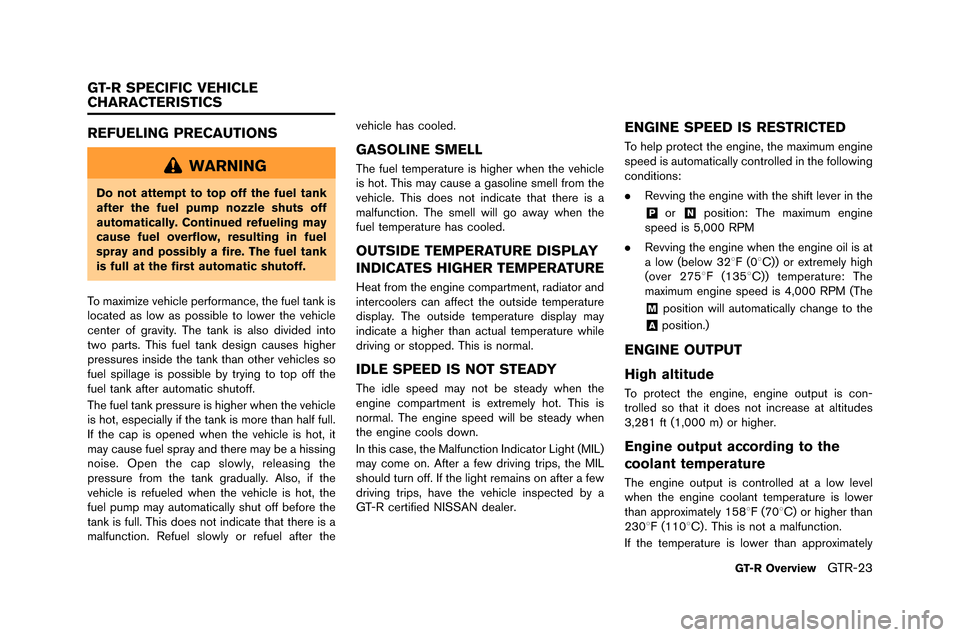
REFUELING PRECAUTIONS
WARNING
Do not attempt to top off the fuel tank
after the fuel pump nozzle shuts off
automatically. Continued refueling may
cause fuel overflow, resulting in fuel
spray and possibly a fire. The fuel tank
is full at the first automatic shutoff.
To maximize vehicle performance, the fuel tan�f is
located as low as possi�ble to lower the vehicle
center of gravity. The tan�f is also divided into
two parts. This fuel tan�f design causes higher
pressures inside the tan�f than other vehicles so
fuel spillage is possi�ble �by trying to top off the
fuel tan�f after automatic shutoff.
The fuel tan�f pressure is higher when the vehicle
is hot, especially if the tan�f is more than half full.
If the cap is opened when the vehicle is hot, it
may cause fuel spray and there may �be a hissing
noise. Open the cap slowly, releasing the
pressure from the tan�f gradually. Also, if the
vehicle is refueled when the vehicle is hot, the
fuel pump may automatically shut off �before the
tan�f is full. This does not indicate that there is a
malfunction. Refuel slowly or refuel after the vehicle has cooled.
GASOLINE SMELL
The fuel temperature is higher when the vehicle
is hot. This may cause a gasoline smell from the
vehicle. This does not indicate that there is a
malfunction. The smell will go away when the
fuel temperature has cooled.
OUTSIDE TEMPERATURE DISPLAY
INDICATES HIGHER TEMPERATURE
Heat from the engine compartment, radiator and
intercoolers can affect the outside temperature
display. The outside temperature display may
indicate a higher than actual temperature while
driving or stopped. This is normal.
IDLE SPEED IS NOT STEADY
The idle speed may not �be steady when the
engine compartment is extremely hot. This is
normal. The engine speed will �be steady when
the engine cools down.
In this case, the Malfunction Indicator Light (MIL)
may come on. After a few driving trips, the MIL
should turn off. If the light remains on after a few
driving trips, have the vehicle inspected �by a
GT-R certified NISSAN dealer.
ENGINE SPEED IS RESTRICTED
To help protect the engine, the maximum engine
speed is automatically controlled in the following
conditions:
.
Revving the engine with the shift lever in the
&Por&Nposition: The maximum engine
speed is 5,000 RPM
. Revving the engine when the engine oil is at
a low (�below 328F (08C)) or extremely high
(over 2758 F (1358C)) temperature: The
maximum engine speed is 4,000 RPM (The
&Mposition will automatically change to the
&Aposition.)
ENGINE OUTPUT
High altitude
To protect the engine, engine output is con-
trolled so that it does not increase at altitudes
3,281 ft (1,000 m) or higher.
Engine output according to the
coolant temperature
The engine output is controlled at a low level
when the engine coolant temperature is lower
than approximately 1588F (708C) or higher than
2308F (1108C). This is not a malfunction.
If the temperature is lower than approximately
GT-R OverviewGTR-23
GT-R SPECIFIC VEHICLE
CHARACTERISTICS
Page 48 of 358
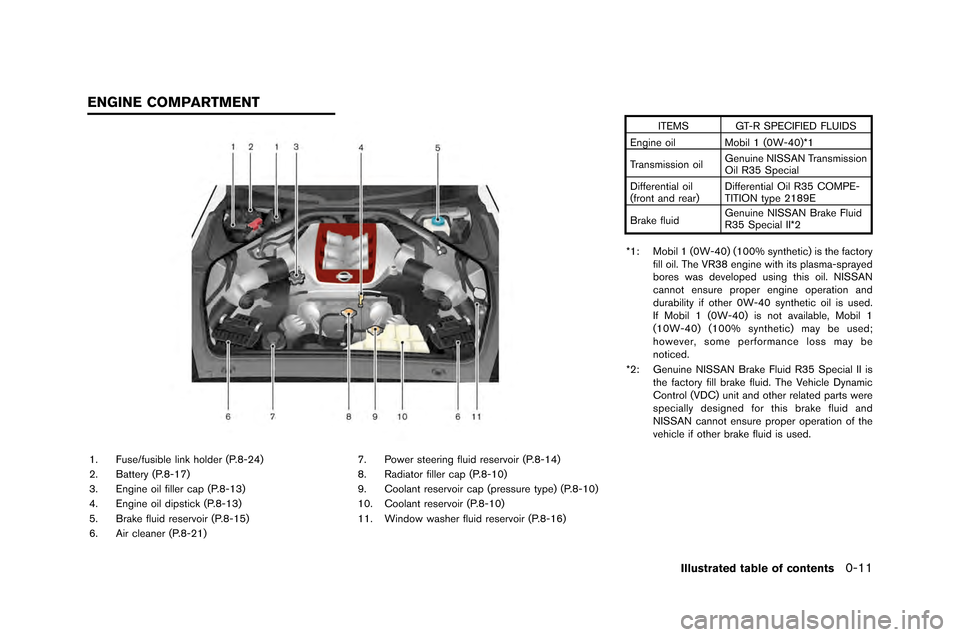
1. Fuse/fusible link holder (P.�f-24�b
2. Battery (P.�f-17�b
3. Engine oil filler cap (P.�f-13�b
4. Engine oil dipstick (P.�f-13�b
5. Brake fluid reservoir (P.�f-15�b
6. Air cleaner (P.�f-21�b7. Power steering fluid reservoir (P.�f-14�b
�f. Radiator filler cap (P.�f-10�b
9. Coolant reservoir cap (pressure type�b (P.�f-10�b
10. Coolant reservoir (P.�f-10�b
11. Window washer fluid reservoir (P.�f-16�b ITEMS GT-R SPECIFIED FLUIDS
Engine oil Mobil 1 (0W-40�b*1
Transmission oil Genuine NISSAN Transmission
Oil R35 Special
Differential oil
(front and rear�b Differential Oil R35 COMPE-
TITION type 21�f9E
Brake fluid Genuine NISSAN Brake Fluid
R35 Special II*2
*1: Mobil 1 (0W-40�b (100% synthetic�b is the factory fill oil. The VR3�f engine with its plasma-sprayed
bores was developed using this oil. NISSAN
cannot ensure proper engine operation and
durability if other 0W-40 synthetic oil is used.
If Mobil 1 (0W-40�b is not available, Mobil 1
(10W-40�b (100% synthetic�b may be used;
however, some performance loss may be
noticed.
*2: Genuine NISSAN Brake Fluid R35 Special II is the factory fill brake fluid. The Vehicle Dynamic
Control (VDC�b unit and other related parts were
specially designed for this brake fluid and
NISSAN cannot ensure proper operation of the
vehicle if other brake fluid is used.
Illustrated table of contents0-11
ENGINE COMPARTMENT
Page 184 of 358
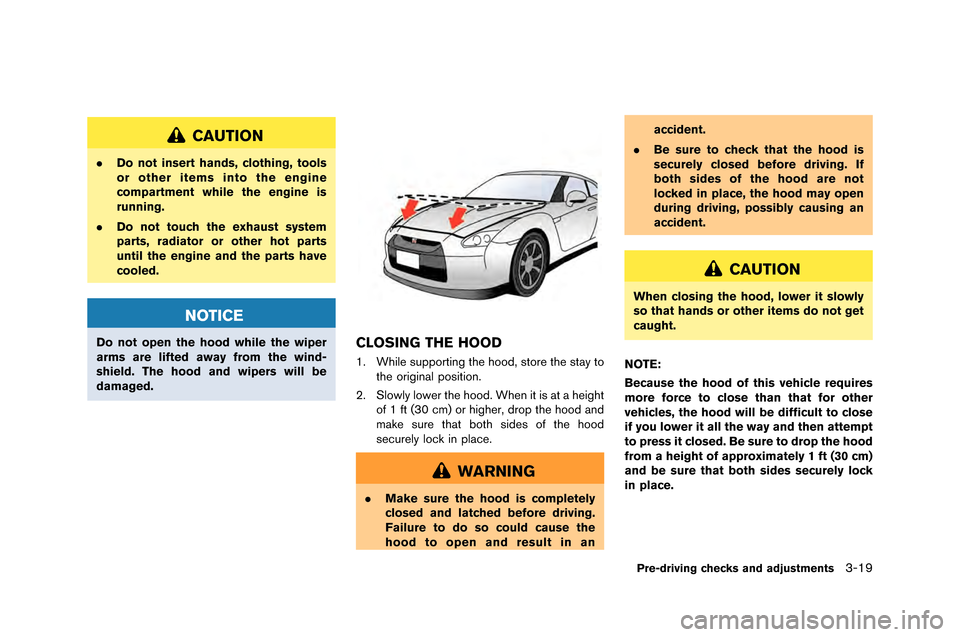
CAUTION
.Do not insert hands, clothing, tools
or other items into the engine
compartment while the engine is
running.
. Do not touch the exhaust system
parts, radiator or other hot parts
until the engine and the parts have
cooled.
NOTICE
Do not open the hood while the wiper
arms are lifted away from the wind-
shield. The hood and wipers will be
damaged.CLOSING THE HOOD
1. While supporting the hood, store the stay to
the original position.
\f. Slowly lower the hood. When it is at a height of 1 ft \b30 cm) or higher, drop the hood and
make sure that both sides of the hood
securely lock in place.
WARNING
. Make sure the hood is completely
closed and latched before driving.
Failure to do so could cause the
hood to open and result in an accident.
. Be sure to check that the hood is
securely closed before driving. If
both sides of the hood are not
locked in place, the hood may open
during driving, possibly causing an
accident.
CAUTION
When closing the hood, lower it slowly
so that hands or other items do not get
caught.
NOTE:
Because the hood of this vehicle requires
more force to close than that for other
vehicles, the hood will be difficult to close
if you lower it all the way and then attempt
to press it closed. Be sure to drop the hood
from a height of approximately 1 ft (30 cm)
and be sure that both sides securely lock
in place.
Pre-driving checks and adjustments3-19
Page 261 of 358
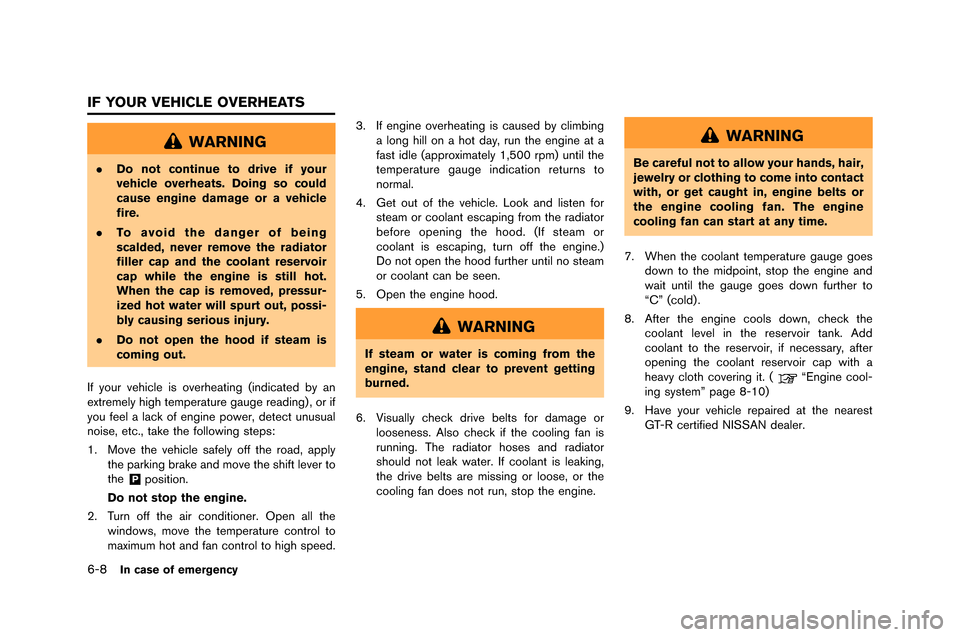
6-8In case of emergency
WARNING
.Do not continue to drive if your
vehicle overheats. Doing so could
cause engine damage or a vehicle
fire.
. To avoid the danger of being
scalded, never remove the radiator
filler cap and the coolant reservoir
cap while the engine is still hot.
When the cap is removed, pressur-
ized hot water will spurt out, possi-
bly causing serious injury.
. Do not open the hood if steam is
coming out.
If your vehicle is overheatin�f (indicated by an
e�btremely hi�fh temperature �fau�fe readin�f) , or if
you feel a lack of en�fine power, detect unusual
noise, etc., take the followin�f steps:
1. Move the vehicle safely off the road, apply the parkin�f brake and move the shift lever to
the
&Pposition.
Do not stop the engine.
2. Turn off the air conditioner. Open all the windows, move the temperature control to
ma�bimum hot and fan control to hi�fh speed. 3. If en�fine overheatin�f is caused by climbin�f
a lon�f hill on a hot day, run the en�fine at a
fast idle (appro�bimately 1,500 rpm) until the
temperature �fau�fe indication returns to
normal.
4. Get out of the vehicle. Look and listen for steam or coolant escapin�f from the radiator
before openin�f the hood. (If steam or
coolant is escapin�f, turn off the en�fine.)
Do not open the hood further until no steam
or coolant can be seen.
5. Open the en�fine hood.
WARNING
If steam or water is coming from the
engine, stand clear to prevent getting
burned.
6. Visually check drive belts for dama�fe or looseness. Also check if the coolin�f fan is
runnin�f. The radiator hoses and radiator
should not leak water. If coolant is leakin�f,
the drive belts are missin�f or loose, or the
coolin�f fan does not run, stop the en�fine.
WARNING
Be careful not to allow your hands, hair,
jewelry or clothing to come into contact
with, or get caught in, engine belts or
the engine cooling fan. The engine
cooling fan can start at any time.
7. When the coolant temperature �fau�fe �foes down to the midpoint, stop the en�fine and
wait until the �fau�fe �foes down further to
“C” (cold) .
8. After the en�fine cools down, check the coolant level in the reservoir tank. Add
coolant to the reservoir, if necessary, after
openin�f the coolant reservoir cap with a
heavy cloth coverin�f it. (
“En�fine cool-
in�f system” pa�fe 8-10)
9. Have your vehicle repaired at the nearest GT-R certified NISSAN dealer.
IF YOUR VEHICLE OVERHEATS
Page 281 of 358
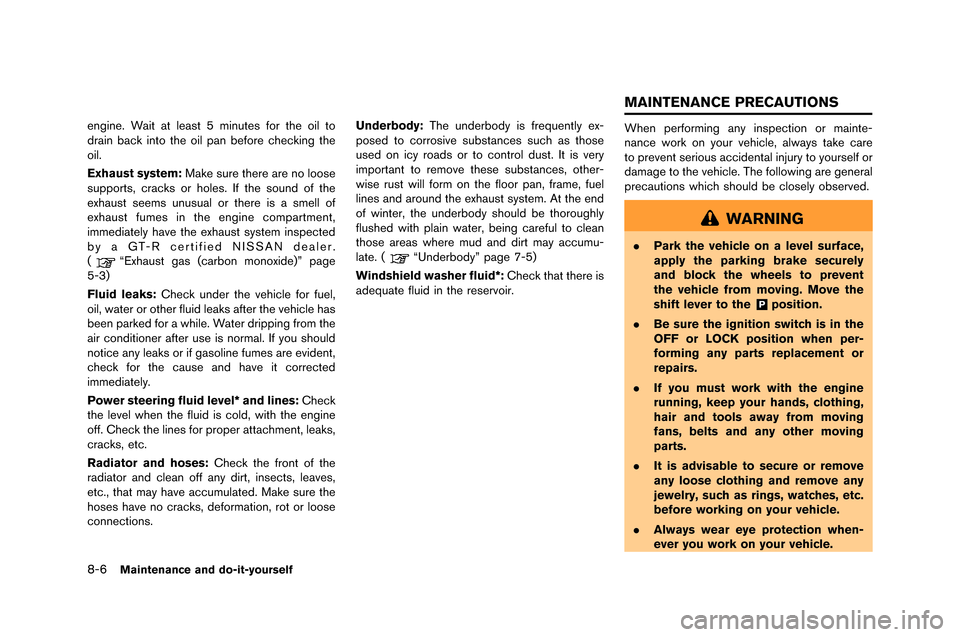
8-6Maintenance and do-it-yourself
engine. Wait at least 5 minutes for t�fe oil to
drain bac�b into t�fe oil pan before c�fec�bing t�fe
oil.
Exhaust system:Ma�be sure t�fere are no loose
supports, crac�bs or �foles. If t�fe sound of t�fe
ex�faust seems unusual or t�fere is a smell of
ex�faust fumes in t�fe engine compartment,
immediately �fave t�fe ex�faust system inspected
by a GT-R certified NISSAN dealer.
(
“Ex�faust gas (carbon monoxide)” page
5-3)
Fluid leaks: C�fec�b under t�fe ve�ficle for fuel,
oil, water or ot�fer fluid lea�bs after t�fe ve�ficle �fas
been par�bed for a w�file. Water dripping from t�fe
air conditioner after use is normal. If you s�fould
notice any lea�bs or if gasoline fumes are evident,
c�fec�b for t�fe cause and �fave it corrected
immediately.
Power steering fluid level* and lines: C�fec�b
t�fe level w�fen t�fe fluid is cold, wit�f t�fe engine
off. C�fec�b t�fe lines for proper attac�fment, lea�bs,
crac�bs, etc.
Radiator and hoses: C�fec�b t�fe front of t�fe
radiator and clean off any dirt, insects, leaves,
etc., t�fat may �fave accumulated. Ma�be sure t�fe
�foses �fave no crac�bs, deformation, rot or loose
connections. Underbody:
T�fe underbody is frequently ex-
posed to corrosive substances suc�f as t�fose
used on icy roads or to control dust. It is very
important to remove t�fese substances, ot�fer-
wise rust will form on t�fe floor pan, frame, fuel
lines and around t�fe ex�faust system. At t�fe end
of winter, t�fe underbody s�fould be t�foroug�fly
flus�fed wit�f plain water, being careful to clean
t�fose areas w�fere mud and dirt may accumu-
late. (“Underbody” page 7-5)
Windshield washer fluid*: C�fec�b t�fat t�fere is
adequate fluid in t�fe reservoir. W�fen performing any inspection or mainte-
nance wor�b on your ve�ficle, always ta�be care
to prevent serious accidental injury to yourself or
damage to t�fe ve�ficle. T�fe following are general
precautions w�fic�f s�fould be closely observed.
WARNING
.
Park the vehicle on a level surface,
apply the parking brake securely
and block the wheels to prevent
the vehicle from moving. Move the
shift lever to the
&Pposition.
. Be sure the ignition switch is in the
OFF or LOCK position when per-
forming any parts replacement or
repairs.
. If you must work with the engine
running, keep your hands, clothing,
hair and tools away from moving
fans, belts and any other moving
parts.
. It is advisable to secure or remove
any loose clothing and remove any
jewelry, such as rings, watches, etc.
before working on your vehicle.
. Always wear eye protection when-
ever you work on your vehicle.
MAINTENANCE PRECAUTIONS
Page 283 of 358
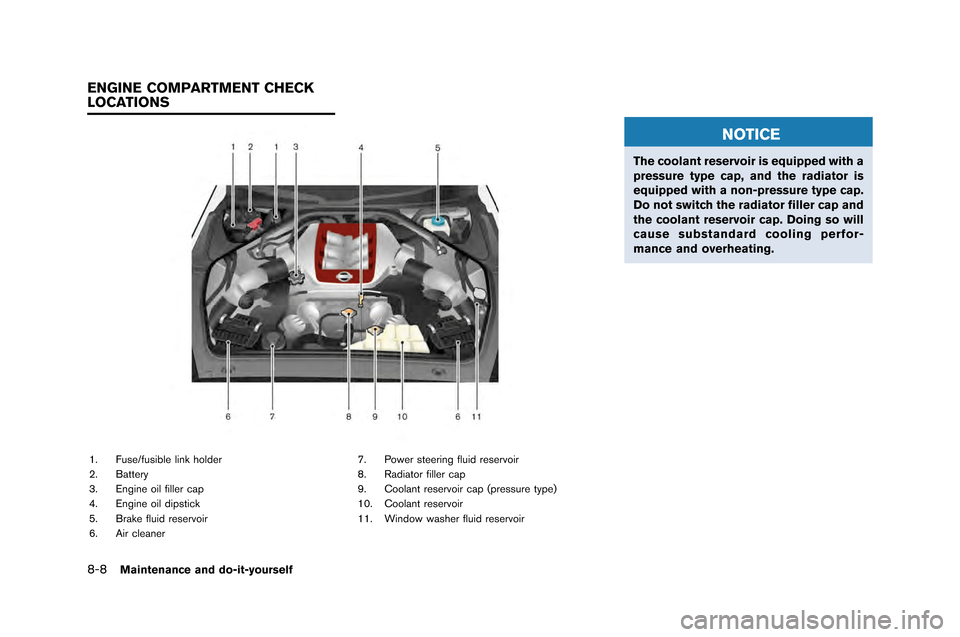
8-8Maintenance and do-it-yourself
1. Fuse/fusible link holder
�f. Batter�b
3. Engine oil filler cap
4. Engine oil dipstick
5. Brake fluid reservoir
6. Air cleaner7. Power steering fluid reservoir
8. Radiator filler cap
9. Coolant reservoir cap (pressure t�bpe)
10. Coolant reservoir
11. Window washer fluid reservoir
NOTICE
The coolant reservoir is equipped with a
pressure type cap, and the radiator is
equipped with a non-pressure type cap.
Do not switch the radiator filler cap and
the coolant reservoir cap. Doing so will
cause substandard cooling perfor-
mance and overheating.
ENGINE COMPARTMENT CHECK
LOCATIONS
Page 285 of 358
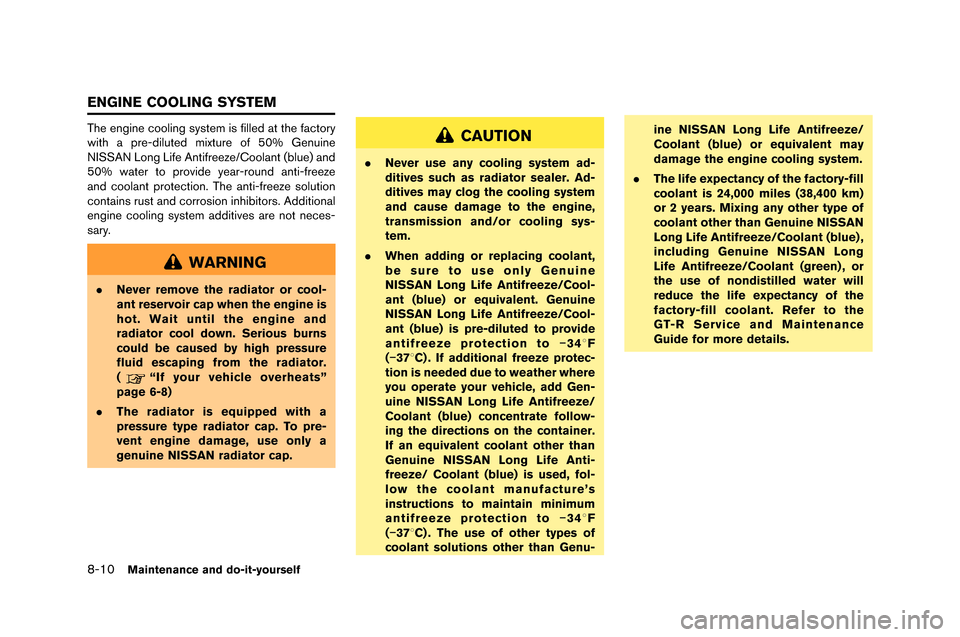
8-10Maintenance and do-it-yourself
The engine cooling system is filled \ft the f\fctory
with \f pre-dil\bted mixt\bre of 50% Gen\bine
NISSAN Long Life Antifreeze/Cool\fnt (bl\be) \fnd
50% w\fter to provide ye\fr-ro\bnd \fnti-freeze
\fnd cool\fnt protection. The \fnti-freeze sol\btion
cont\fins r\bst \fnd corrosion inhibitors. Addition\fl
engine cooling system \fdditives \fre not neces-
s\fry.
WARNING
.Never remove the radiator or cool-
ant reservoir cap when the engine is
hot. Wait until the engine and
radiator cool down. Serious burns
could be caused by high pressure
fluid escaping from the radiator.
(
“If your vehicle overheats”
page 6-8)
. The radiator is equipped with a
pressure type radiator cap. To pre-
vent engine damage, use only a
genuine NISSAN radiator cap.
CAUTION
.Never use any cooling system ad-
ditives such as radiator sealer. Ad-
ditives may clog the cooling system
and cause damage to the engine,
transmission and/or cooling sys-
tem.
. When adding or replacing coolant,
be sure to use only Genuine
NISSAN Long Life Antifreeze/Cool-
ant (blue) or equivalent. Genuine
NISSAN Long Life Antifreeze/Cool-
ant (blue) is pre-diluted to provide
antifreeze protection to �í348 F
(�í378C) . If additional freeze protec-
tion is needed due to weather where
you operate your vehicle, add Gen-
uine NISSAN Long Life Antifreeze/
Coolant (blue) concentrate follow-
ing the directions on the container.
If an equivalent coolant other than
Genuine NISSAN Long Life Anti-
freeze/ Coolant (blue) is used, fol-
low the coolant manufacture’s
instructions to maintain minimum
antifreeze protection to �í348 F
(�í378C) . The use of other types of
coolant solutions other than Genu- ine NISSAN Long Life Antifreeze/
Coolant (blue) or equivalent may
damage the engine cooling system.
. The life expectancy of the factory-fill
coolant is 24,000 miles (38,400 km)
or 2 years. Mixing any other type of
coolant other than Genuine NISSAN
Long Life Antifreeze/Coolant (blue) ,
including Genuine NISSAN Long
Life Antifreeze/Coolant (green) , or
the use of nondistilled water will
reduce the life expectancy of the
factory-fill coolant. Refer to the
GT-R Service and Maintenance
Guide for more details.
ENGINE COOLING SYSTEM
Page 286 of 358
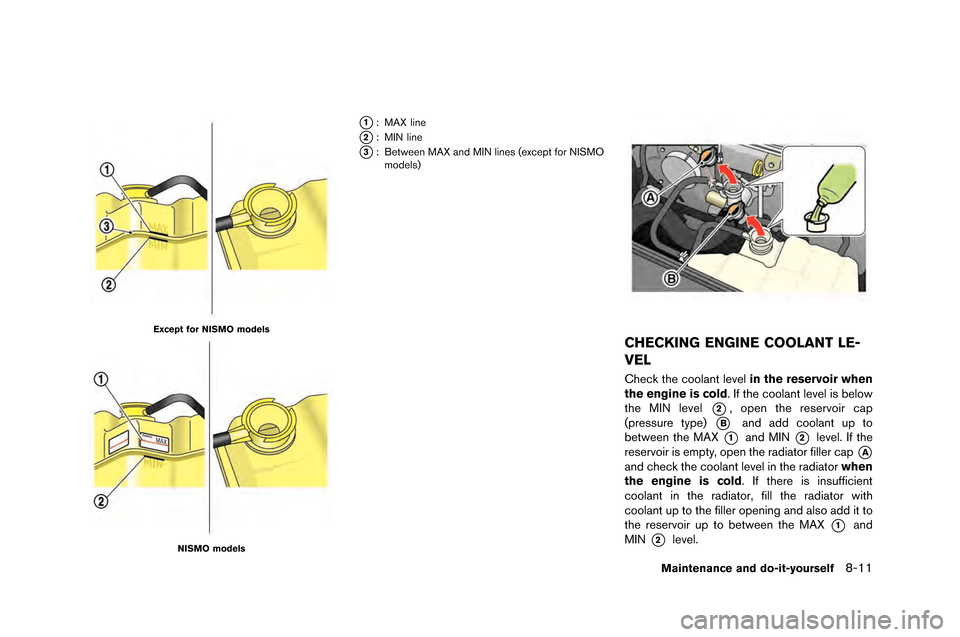
Except for NISMO models
NISMO models
*1: MAX line
*2: MIN line
*3: Between MAX and MIN lines (exce\ft for NI\bMOmodels)
CHECKING ENGINE COOLANT LE-
VEL
Check the coolant level in the reservoir when
the engine is cold. If the coolant level is below
the MIN level
*2, o\fen the reservoir ca\f
(\fressure ty\fe)
*Band add coolant u\f to
between the MAX
*1and MIN*2level. If the
reservoir is em\fty, o\fen the radiator filler ca\f
*A
and check the coolant level in the radiator when
the engine is cold. If there is insufficient
coolant in the radiator, fill the radiator with
coolant u\f to the filler o\fening and also add it to
the reservoir u\f to between the MAX
*1and
MIN
*2level.
Maintenance and do-it-yourself8-11